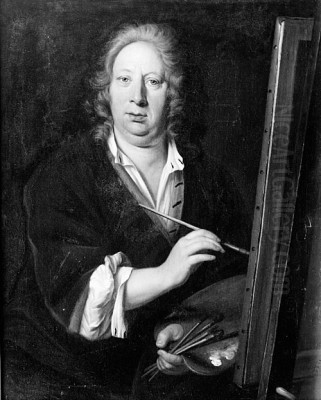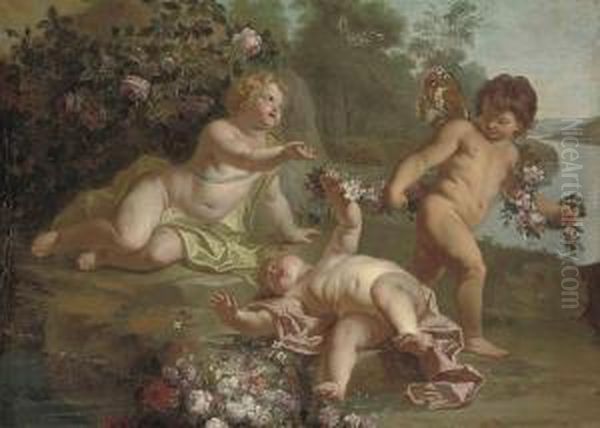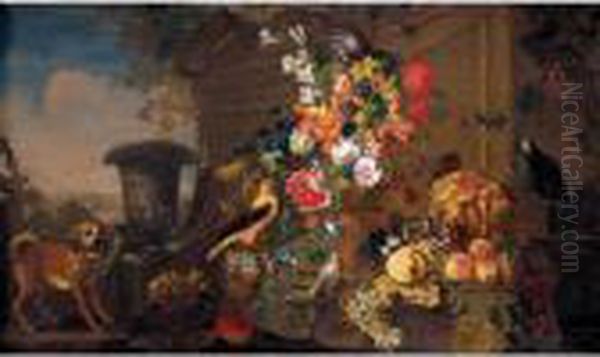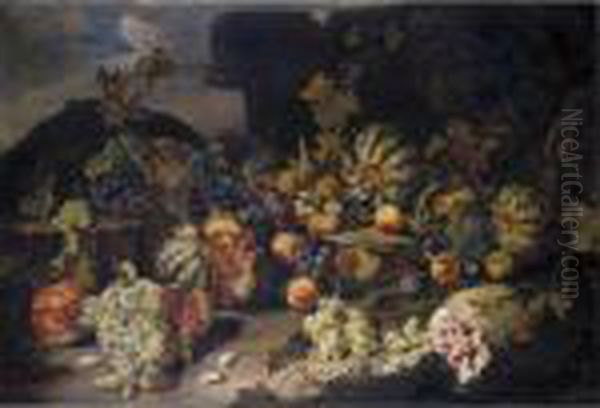
Franz Werner von Tamm, a distinguished painter of the Baroque era, carved a significant niche for himself through his exquisite still life compositions, particularly those featuring flowers, fruits, and animals. Born in Germany, his artistic journey led him through the vibrant art scenes of Italy and eventually to the imperial court in Vienna. His works are celebrated for their meticulous detail, rich coloration, and the harmonious blend of Northern European precision with Italianate decorative flair, reflecting the cosmopolitan artistic currents of the late 17th and early 18th centuries.
Early Life and Artistic Genesis
Franz Werner von Tamm was born in the bustling port city of Hamburg, Germany, in 1658. At this time, Hamburg was a prominent member of the Hanseatic League and a thriving center of commerce and culture. While specific details about his earliest artistic training in Hamburg are scarce, it is probable that he was exposed to the rich traditions of Northern European painting, which emphasized realism, detailed observation, and a mastery of textures. The city's art scene would have included local masters and influences from the nearby Netherlands, a powerhouse of still life and genre painting. Artists like Willem Kalf or Abraham Mignon, though Dutch, set high standards for still life painting that resonated across Northern Europe, and young Tamm may have encountered their works or those of their followers.
The artistic environment of Northern Europe during the mid-17th century was characterized by a burgeoning market for various genres, including portraits, landscapes, and especially still lifes. These still lifes ranged from opulent "pronkstilleven" (ostentatious still lifes) to more subdued "vanitas" paintings, reminding viewers of life's transience. This cultural backdrop likely provided Tamm with his initial grounding in the meticulous rendering of objects, a skill that would become a hallmark of his mature style. His decision to later travel to Italy suggests a desire to broaden his artistic horizons and engage with the classical and High Baroque traditions prevalent there.
The Roman Sojourn: Influences and Development

In 1685, Franz Werner von Tamm made the pivotal decision to move to Rome, the undisputed center of the European art world. This city was a magnet for artists from across the continent, all eager to study its classical antiquities and the masterpieces of Renaissance and Baroque art. In Rome, Tamm immersed himself in a dynamic artistic milieu. He became associated with the "Bentvueghels" (Dutch for "birds of a feather"), a society of mostly Dutch and Flemish artists active in Rome. This confraternity was known for its bohemian lifestyle, its initiation rituals, and the practice of giving members a catchy nickname, or "bentnaam." Tamm was bestowed with the nickname "Dapper" or "Dapperheid," meaning "Courage" or "Bravery," a testament perhaps to his character or artistic ambition.
A crucial aspect of Tamm's development in Rome was his association with the studio of Carlo Maratta (1625–1713). Maratta was the leading painter in Rome during the later 17th century, celebrated for his classical Baroque style that continued the tradition of Raphael and Annibale Carracci, tempered with a softer, more graceful manner. Studying under or alongside Maratta would have exposed Tamm to the principles of grand composition, idealized forms, and a refined palette. Maratta's studio was a hub of artistic activity, and his influence extended to numerous pupils and followers, including Giuseppe Bartolomeo Chiari and Benedetto Luti, who became significant painters in their own right. Through Maratta, Tamm would have also been connected to the artistic lineage of Andrea Sacchi, one of Maratta's teachers, and the classical ideals of artists like Guido Reni.
While Maratta was primarily known for his religious and mythological scenes, his emphasis on drawing, composition, and color would have been invaluable for a still life painter like Tamm. It was in Rome that Tamm began to specialize in still lifes of flowers, fruits, game, and live animals. His style during this period started to show a synthesis of influences. He absorbed the decorative richness of Italian Baroque still life, exemplified by artists like Mario Nuzzi, also known as "Mario de' Fiori," whose lush floral compositions were highly sought after. Nuzzi's work, often characterized by abundant, colorful bouquets, would have offered a vibrant counterpoint to the more restrained Northern traditions.

Furthermore, Tamm did not abandon his Northern European roots. He diligently studied the works of Dutch and Flemish masters whose paintings were available in Roman collections or who were themselves active in Italy. The provided information specifically mentions his admiration for Jan Weenix (1642–1719) and Melchior d'Hondecoeter (1636–1695). Weenix was renowned for his elaborate hunting still lifes (dead game) and scenes with live animals set in park-like landscapes, characterized by fine detail and rich textures. Hondecoeter was the preeminent painter of birds, creating lively and decorative compositions of domestic and exotic fowl. The influence of these artists encouraged Tamm to refine his technique, achieving even greater clarity and meticulousness in his depictions. Other Netherlandish artists active in Rome around this time, such as Abraham Brueghel, known for his sumptuous fruit and flower pieces, and Karel van Vogelaer, another flower painter and Bentvueghel member, would have contributed to the rich tapestry of still life painting in the city. David de Coninck, a Flemish painter of animals and still lifes, also spent time in Rome and shared thematic interests with Tamm.
Tamm's Roman period, lasting until 1695, was thus a formative decade where he honed his skills, absorbed diverse influences, and established his reputation as a specialist in still life painting. His ability to combine the detailed realism and textural finesse of Northern art with the grandeur and decorative appeal of the Italian Baroque set his work apart.
Artistic Style and Thematic Focus
Franz Werner von Tamm's artistic style is firmly rooted in the Baroque tradition, yet it possesses distinctive characteristics shaped by his diverse training and influences. His primary focus was on still life, a genre that allowed for meticulous observation and the display of technical virtuosity. He excelled in depicting a wide array of subjects within this genre, including elaborate floral arrangements, groupings of fruit, hunting trophies (dead game such as birds and hares), and compositions featuring live animals, particularly birds and small mammals like guinea pigs.
A hallmark of Tamm's style is the remarkable detail and realism he brought to his subjects. Each petal, leaf, feather, or piece of fruit is rendered with precision, capturing its unique texture, color, and form. This meticulousness is a legacy of his Northern European artistic heritage. However, his compositions often possess a decorative opulence and a sense of abundance that align with Italian Baroque sensibilities. He skillfully arranged his subjects to create visually engaging and harmonious compositions, often employing dynamic diagonals or pyramidal structures common in Baroque art.
His color palette was typically rich and vibrant, with a keen sensitivity to tonal gradations and the interplay of light and shadow. This use of chiaroscuro not only enhanced the three-dimensionality of the objects but also contributed to the overall mood and atmosphere of his paintings. He was adept at capturing the sheen of silk, the softness of fur, the translucency of grapes, and the velvety texture of flower petals. The lighting in his works is often carefully controlled, highlighting key elements and creating a sense of depth and drama.

Tamm's paintings often go beyond mere representation. While not overtly didactic in the manner of some "vanitas" still lifes, his depictions of flowers in full bloom, ripe fruit, and captured game can be seen to touch upon themes of nature's bounty, the cycle of life and death, and the fleeting beauty of the material world. The inclusion of hunting motifs, popular in aristocratic circles, also spoke to a lifestyle of leisure and privilege. His works were designed to appeal to the sophisticated tastes of his patrons, offering both aesthetic delight and a display of the painter's consummate skill. The decorative quality of his paintings made them suitable for adorning the interiors of wealthy homes and palaces.
He often incorporated elements like ornate vases, classical architectural fragments, or glimpses of landscapes in the background, adding layers of interest and context to his still lifes. This practice, common among Baroque still life painters, helped to elevate the genre beyond simple imitation of nature, imbuing it with a sense of artistry and intellectual engagement.
Key Works and Their Characteristics
While a comprehensive catalogue of Franz Werner von Tamm's oeuvre requires extensive research, several works are frequently cited as representative of his style and thematic concerns. These paintings showcase his technical skill, his eye for detail, and his ability to create visually sumptuous compositions.
One such work is "Still Life with Flowers and Guinea Pigs" (the original Chinese source mentions "Guinevere Pigs," a likely mistranslation). This painting would exemplify Tamm's ability to combine floral elements with live animals. One can imagine a lush arrangement of various flowers – roses, tulips, carnations, and others – rendered with botanical accuracy, their vibrant colors and delicate textures meticulously captured. The inclusion of guinea pigs, small, exotic pets at the time, would add a touch of whimsy and life to the composition. Tamm would have paid close attention to the soft fur of the animals and their interaction with the surrounding flora, creating a harmonious and engaging scene.
Another significant piece is "Flowers, Fruits and Parrot at the Threshold of a Landscape" (original French title: Fleurs, fruits et perroquet au seuil d'un paysage). This title suggests a complex composition, likely featuring an abundant display of flowers and fruits in the foreground, perhaps spilling from a basket or arranged on a ledge. The parrot, an exotic and colorful bird, would serve as a vibrant focal point, its plumage rendered with Tamm's characteristic precision. The phrase "at the threshold of a landscape" indicates that the still life elements are not isolated but are connected to a broader outdoor setting, possibly a garden or park, a common convention in Baroque still life that added depth and a sense of naturalism.
The "Garland of Flowers" , mentioned as being in the Louvre and dating to the early 18th century, points to a specific subgenre of floral painting. Garland paintings, often surrounding a central image (which could be a religious scene, a portrait, or even an empty space), were popular in the Baroque period. Tamm's version, described as non-religious, would focus on the sheer beauty and variety of the flowers themselves, woven into an intricate and decorative wreath. Such a work would showcase his mastery in depicting different floral species, their colors, and textures, creating a piece of "splendor" that reflects the opulence of 17th-century Roman painting traditions, even if executed later.
"Two Canaries with Vegetables" is another indicative title. This painting would likely feature the delicate forms of canaries, popular cage birds, juxtaposed with an assortment of vegetables. This combination allows for a play of textures and colors – the soft yellow of the canaries against the greens, reds, and earthy tones of the vegetables. Such a composition would highlight Tamm's versatility in rendering both animal life and botanical subjects with equal finesse.
These works, and others like them, demonstrate Tamm's commitment to the detailed and decorative aspects of still life painting. He often included elements like dead game birds, reflecting the influence of artists like Jan Weenix, adding a touch of the hunt to his compositions. His paintings are characterized by their careful balance, rich coloration, and the almost tangible quality of the objects depicted. They served not only as beautiful objects in themselves but also as status symbols for their owners, reflecting a taste for refinement and an appreciation for the wonders of the natural world, artfully rearranged by the painter.
The Viennese Period: Court Painter and Mature Style
In 1695, Franz Werner von Tamm relocated from Rome to Vienna, the capital of the Habsburg Empire. This move marked a new and prestigious phase in his career, as he was appointed a court painter (Hofmaler) to the imperial court. Vienna at this time was a major European cultural center, and the Habsburg emperors were significant patrons of the arts, fostering a vibrant artistic environment. Artists like Johann Michael Rottmayr and Peter Strudel were prominent figures in Austrian Baroque painting during this period, contributing to large-scale decorative schemes in palaces and churches.
The position of court painter was highly esteemed and provided Tamm with a degree of financial security and access to influential patrons. It also meant that his work would be in demand for decorating imperial residences and for the collections of the nobility. In Vienna, Tamm continued to specialize in still life paintings, bringing his refined style, honed in Rome through the study of both Italian and Netherlandish masters, to a new audience.
His paintings from the Viennese period likely maintained the high level of detail, rich color, and decorative elegance that characterized his Roman work. The themes of flowers, fruits, game, and animals remained central to his output. It is possible that the tastes of the Viennese court influenced certain aspects of his compositions, perhaps favoring even more opulent displays or specific symbolic content relevant to his patrons. His experience and reputation would have allowed him to command significant commissions.
The influence of Dutch masters like Jan Weenix and Melchior d'Hondecoeter, which he had cultivated in Rome, would have continued to inform his depictions of game and birds. His ability to render textures – the softness of feathers, the sheen of fur, the bloom on fruit – would have been highly appreciated. He may have also collaborated with other artists at court, a common practice where specialists in different genres (e.g., figure painters and still life painters) would work together on larger compositions.
While the provided information does not detail specific interactions with Viennese contemporary painters, his presence at court would have undoubtedly placed him within a circle of accomplished artists. His work would have been seen alongside that of Austrian masters and other international artists attracted to the Habsburg capital. His style, blending Northern precision with Italianate grandeur, would have offered a distinct contribution to the Viennese art scene. He continued to work in Vienna until his death in 1724, leaving behind a legacy as a master of Baroque still life. His paintings from this period would represent the culmination of his artistic development, reflecting a mature and confident style.
Legacy and Influence
Franz Werner von Tamm's legacy lies in his skillful synthesis of various artistic traditions within the genre of still life painting. He successfully merged the meticulous realism and detailed observation characteristic of Northern European art, particularly Dutch and Flemish schools, with the decorative grandeur and compositional dynamism of the Italian Baroque. This fusion resulted in works that were both intellectually engaging for their verisimilitude and aesthetically pleasing for their opulence and harmony.
His influence extended to his contemporaries and subsequent painters. The provided information notes that his work impacted Neapolitan artists, with at least one painter in Naples attempting to emulate his technique in flower painting. This suggests that his reputation and the quality of his art were recognized beyond the immediate circles in which he worked. Naples, being a vibrant artistic center with its own strong tradition of still life painting (with artists like Paolo Porpora or Giuseppe Recco), would have been receptive to new stylistic impulses.
Tamm's dedication to the careful study of masters like Jan Weenix and Melchior d'Hondecoeter, and his ability to adapt their approaches to his own vision, demonstrates a thoughtful engagement with artistic tradition. He did not merely imitate but rather absorbed and transformed these influences. His reported collaboration with Carlo Maratta in Rome, even if primarily as a student or studio associate, placed him in contact with one of the leading figures of Roman classicism, which likely refined his sense of composition and form.
His appointment as a court painter in Vienna further solidified his status and ensured that his works were disseminated among the elite, contributing to the appreciation of still life painting in Central Europe. Artists like Franz de Hamilton, who was also active in Germany and Austria around the same time and painted similar subjects, operated within a comparable artistic milieu. Tamm's paintings would have served as exemplars of the genre, showcasing the heights of technical skill and artistic refinement that still life could achieve.
In the broader context of Baroque still life, Tamm's work represents a significant contribution, particularly in its international character. He was part of a network of artists who traveled, studied, and worked in different cultural centers, facilitating the exchange of styles and ideas. His paintings, with their rich colors, detailed execution, and often luxurious subject matter, perfectly encapsulated the Baroque era's fascination with the natural world, its taste for decorative splendor, and its appreciation for artistic virtuosity. Today, his works are found in various museums and private collections, attesting to his enduring appeal as a master of still life.
Conclusion
Franz Werner von Tamm stands as a notable figure in the history of Baroque art, a German-born painter whose career flourished in the major artistic centers of Rome and Vienna. His specialization in still life – encompassing flowers, fruits, game, and animals – allowed him to showcase his exceptional technical abilities and his keen observational skills. From his early exposure to Northern European traditions in Hamburg to his formative years in Rome under the influence of Carlo Maratta and Dutch masters like Jan Weenix and Melchior d'Hondecoeter, and finally to his esteemed position as a court painter in Vienna, Tamm consistently produced works of remarkable detail, vibrant color, and decorative elegance.
His nickname "Dapperheid" from his Bentvueghels days in Rome hints at a spirited artist who confidently navigated the competitive art world of his time. He successfully forged a distinctive style that harmonized the precision of the North with the grandeur of the Italian Baroque, creating still lifes that appealed to the sophisticated tastes of his patrons. Through works like "Still Life with Flowers and Guinea Pigs," "Flowers, Fruits and Parrot at the Threshold of a Landscape," and "Garland of Flowers," Franz Werner von Tamm left an indelible mark on the genre, and his paintings continue to be admired for their beauty, craftsmanship, and their embodiment of the Baroque aesthetic.